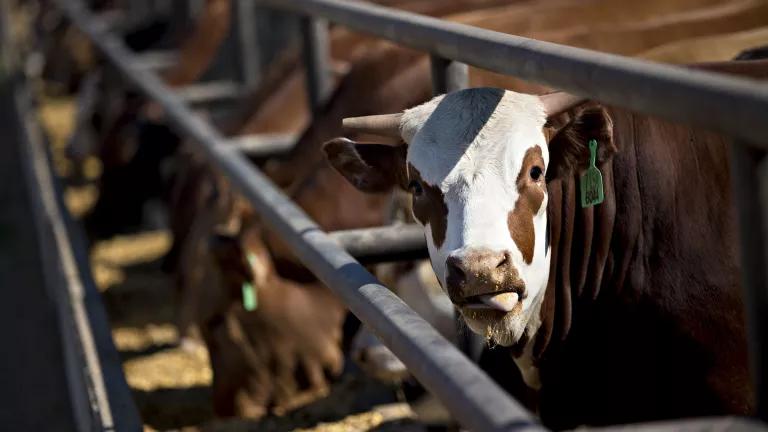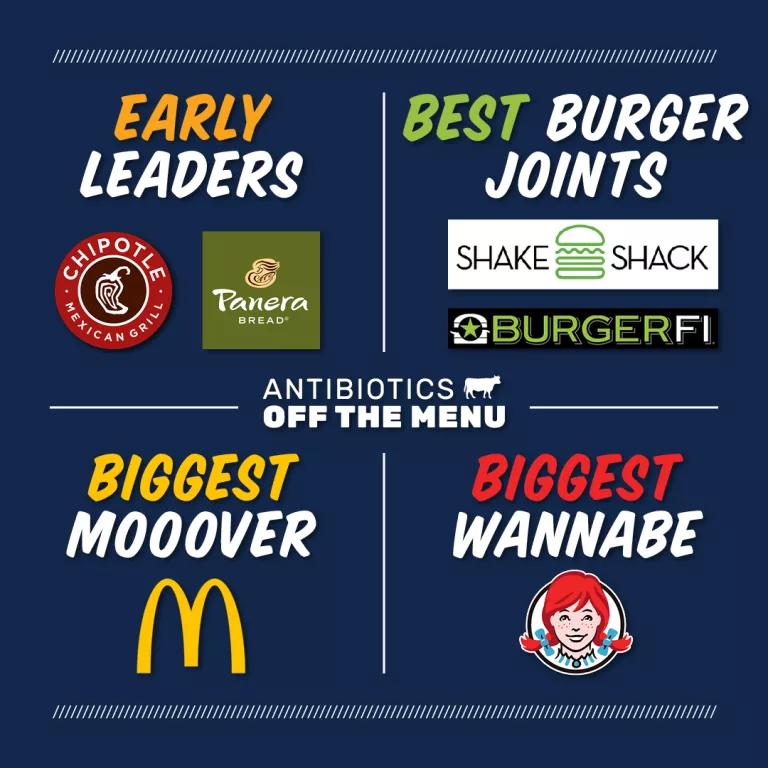Fast-Food and Beef Industries Are Still Fueling Scary Superbugs
The latest “Chain Reaction” report grades restaurants’ antibiotics-use policies—and there are a lot of Fs.

Here’s a real-life horror story: Antibiotics increasingly fail to work when sick people need them. Antibiotic resistance in some bacteria has nearly doubled in the past two decades, and patients can develop resistance to a last-resort drug in less than a month, according to recently published medical research.
Yet the beef industry continues to use massive amounts of these lifesaving drugs on cattle, often when the animals aren’t sick, a widespread practice that is helping to fuel this growing crisis. In fact, two-thirds of the medically important antibiotics sold in this country in 2017 were for use on livestock, not people, with more going to cows than to any other livestock.
As some of the nation’s largest beef buyers, major restaurant chains have the power to be the heroes of this tale. But a new report out today from NRDC and allies shows that so far, most are falling down on the job. The fifth edition of the Chain Reaction Antibiotics Scorecard shows that nearly all of the nation’s top restaurant chains currently lack policies that restrict routine use of medically important antibiotics in their beef supplies—and most have no plans in place to change that. As a result, nearly all received poor grades this year, with the majority earning Fs.

A grade, however, can reveal only so much about what these chains are doing. In an effort to tell more of the story , this year’s report also includes superlatives for restaurants that stood out from the pack, for better or worse.

Notably, Wendy’s landed the “Biggest Wannabe” award for working hard to publicly paint itself as a leader when in fact the steps it has taken do very little to address the problem in its beef supply. There are more than two dozen medically important antibiotics approved for use in the cattle industry. Yet the company has vowed to cut just one antibiotic by just 20 percent, and in only 30 percent of its overall beef supply. Wendy’s knows consumers want to eat responsibly raised meat, so it’s trying to get credit here without making a meaningful effort to earn it.
This piecemeal approach is not nearly enough to match the urgency or the gravity of the antibiotic resistance health crisis. That is why last month, NRDC and our allies in the Antibiotics Off the Menu coalition delivered petitions signed by more than 125,000 people around the country calling on the company to take meaningful action. We are looking for Wendy’s—as well as other major beef buyers—to set comprehensive policies for its supply chains that phase out the routine use of medically important antibiotics and come with firm completion deadlines.
In contrast, McDonald’s—the largest beef purchaser in the world—offered us the brightest glimmer of hope in the past year. Last December, it became the biggest fast-food chain to commit to curtailing routine use of medically important antibiotics across its vast global beef supply chain and to set concrete reduction targets by the end of 2020.

A burger from McDonald’s
This action earned McDonald’s the “Biggest Moover” award in our report this year. The company still earned only a C on our scorecard, however, because we’re still waiting on those reduction targets and, ultimately, the actual phaseout of the drugs in it beef supply. But we’re hopeful McDonald’s will continue to improve its grade in the years to come. If so, it could set off the domino effect we’re waiting for.
With consumers increasingly demanding better meat, the writing is on the wall, and the companies that respond will have the competitive edge. In fact, BurgerFi, one of the winners of our “Best Burger Joint” superlative this year, credits its A grade in last year’s report as a reason the U.S. Air Force selected it as a vendor for a handful of bases across the country, part of its effort to enhance food quality in response to millennial demand. As the chief of strategy and innovation at the Air Force Services Center put it, “A younger, more socially aware demographic is in service, and the products and services that provided value to previous generations are no longer relevant.”
“No longer relevant.” Ouch. Let that sink in, fast-food CEOs.
While our report suggests things are looking bleak for beef right now, history has shown that a lot can change in a few short years. These companies have the power to turn things around.
Just look to the chicken industry: When we launched this scorecard five years ago, nearly half of the U.S. chicken industry was using medically important antibiotics. As of the end of 2018, more than 90 percent of the chicken sold in the United States was raised without the routine use of antibiotics deemed medically important by the U.S. Food and Drug Administration. That’s a stunning success story that unfolded in a very short time.
What’s more, many of the same fast-food companies that got poor grades in today’s report for their beef policies drove that positive change in chicken. They can do it again with beef.
Customers want better beef. We want antibiotics to work when we need them. We want the nation’s largest beef buyers to do their part and turn up the heat on their suppliers. Our lives are on the line.




